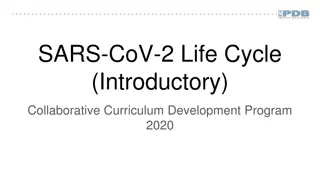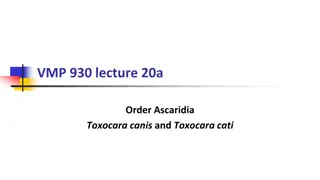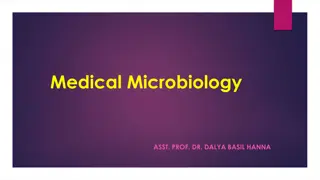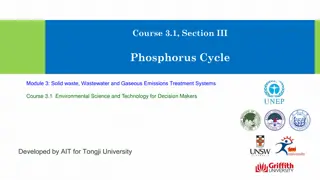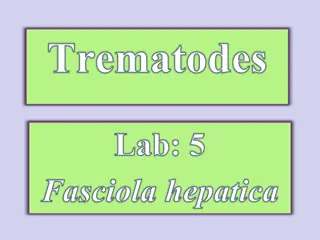Comprehensive Overview of Toxocara canis Life Cycle and Characteristics
Toxocara canis, also known as the Arrow-headed worm, is a parasite commonly found in dogs, particularly in puppies less than six months old. This article explores the general characteristics, life cycle, transmission routes, and prenatal infections of Toxocara canis. From the appearance of the male and female worms to the infective stages and migration processes, the life cycle of this parasite is discussed in detail. Understanding these aspects is crucial for effective prevention and control of Toxocara canis infections in dogs.
Download Presentation

Please find below an Image/Link to download the presentation.
The content on the website is provided AS IS for your information and personal use only. It may not be sold, licensed, or shared on other websites without obtaining consent from the author. Download presentation by click this link. If you encounter any issues during the download, it is possible that the publisher has removed the file from their server.
E N D
Presentation Transcript
Toxocara canis Family: Ascarididae Bihar Animal Sciences University | Dr. AJIT KUMAR Dr. AJIT KUMAR Department of Veterinary Parasitology Department of Veterinary Parasitology Bihar Veterinary College Bihar Veterinary College Bihar Animal Sciences University Bihar Animal Sciences University Patna Patna- -800014 800014 Image source: Google image
Toxocara canis o Common Name : Arrow headed worm o Final Host/ Host: Dog o Predilection site: Small Intestine Highest recorded in dogs of less than six months of age. prevalences have been o
Toxocara canis General Characters: o Male are up to 10 cm whereas Females are up to 18 cm long o Presence of large cervical alae which gives appearance. Hence, known as Arrow-headed worms. arrow-like o Anterior end is bent dorsally o Tail of male worm bears a small finger like process. o Egg are subglobular in shape, dark brown unsegmented embryos at the centre with thick finely pitted shells. in colour Egg
Toxocara canis Life Life- -cycle cycle: : o Direct life-cycle o Infective stage: egg containing 2nd stage larvae. Transmission: There are four routes canis transmission: of Toxocara 1 1. . Oral infective infective egg It migration similar to A. suum. It occurs in puppies of a few weeks to less than three months of age. Oral or or ingestion ingestion of egg containing containing L L2 2 follows of of tracheal larvae
Toxocara canis Life Life- -cycle cycle: : 2. Transuterine Transuterine infection Prenatal Prenatal or or Congenital Congenital infections In dogs over three months of age, the hepatic- tracheal migration occurs less frequently and at six months it has almost ceased. infection or infections : : or Transplacental Transplacental or or Instead, only somatic migration of L2 larvae and these remain in L2 stage in organs/tissues. In the pregnant bitch, prenatal infection occurs, larvae becoming mobilized at about three weeks prior to parturition and migrating to the liver of the foetus where they moult to L3 just before birth. A bitch, once infected, will usually harbours sufficient larvae to infect all her subsequent litters, even if she never gain encounters the infection. Mobilization and migration of larvae induce probably due to alteration of hormonal status during pregnancy stage.
Toxocara canis Life Life- -cycle cycle: : o Direct life-cycle o Infective stage: egg containing 2nd stage larvae. Transmission: There are four routes canis transmission: of Toxocara 1 1. . Oral infective infective egg It migration similar to A. suum. It occurs in puppies of a few weeks to less than three months of age. Oral or or ingestion ingestion of egg containing containing L L2 2 follows of of tracheal larvae
Toxocara canis Life Life- -cycle cycle: : 3 3. .Transmammary Transmammary Transmission L3 larvae are passed to suckling pups colostrums directly to adult worms in the intestine of the puppy. There is no migration in the pup following infection by this route. 4 4. . Paratenic Paratenic host host transmission Dogs, being predators, may eat on rodents dormant larvae. L2 stage develops to adult stage in the intestine of pups/dogs migration. Transmission via develop the and transmission having without
Toxocara canis Pathogenesis: Most fatalities from Toxocara canis infection occur during the pulmonary phase, and pups which have been heavily infected transplacentaly may die within a few days of birth. Larvae are caused oedema, haemorrhages, etc whereas adult worms lead to enteritis and occlusion of intestine. o pneumonia, pulmonary o Intestinal Obstruction
Toxocara canis Clinical signs: Pot-belly or tucked-up abdomen, coat is dull and harsh, nervous convulsions and diarrhoea or constipation, coughing, poor body condition, loss of appetite etc. Death of pups occurs due to heavy prenatal infection as well as blocking of intestine. o vomiting, o
Toxocara canis Diagnosis: o On the basis of Clinical signs. o Gross examination of faeces: o Microscopic faecal examination: Egg are subglobular in shape, dark brown in colour embryos at the centre with thick finely pitted shells. unsegmented
Toxocara canis Treatment Treatment: : Piperazine pamoate, Diethylcarbamazine and Levamisole are used in the treatment. Control Control: : Toxocara canis infected bitches should be treated with fenbendazole which is also effective against dormant larvae in tissues to may prevent prenatal infection. Floor of kennels should be kept clean, dry and washed either by boiling water or 3% Lysol solution. Rodents should be eliminated from the kennel. Deworming Deworming Schedule Schedule: : adipate, Fenbendazole, Pyrantel o o o o Puppies : 2 wks, 4 wks, 6wks, 8wks, 12 wks, 16 wks, 6 months and 1 year Adult dogs: twice in a year
THANK YOU




